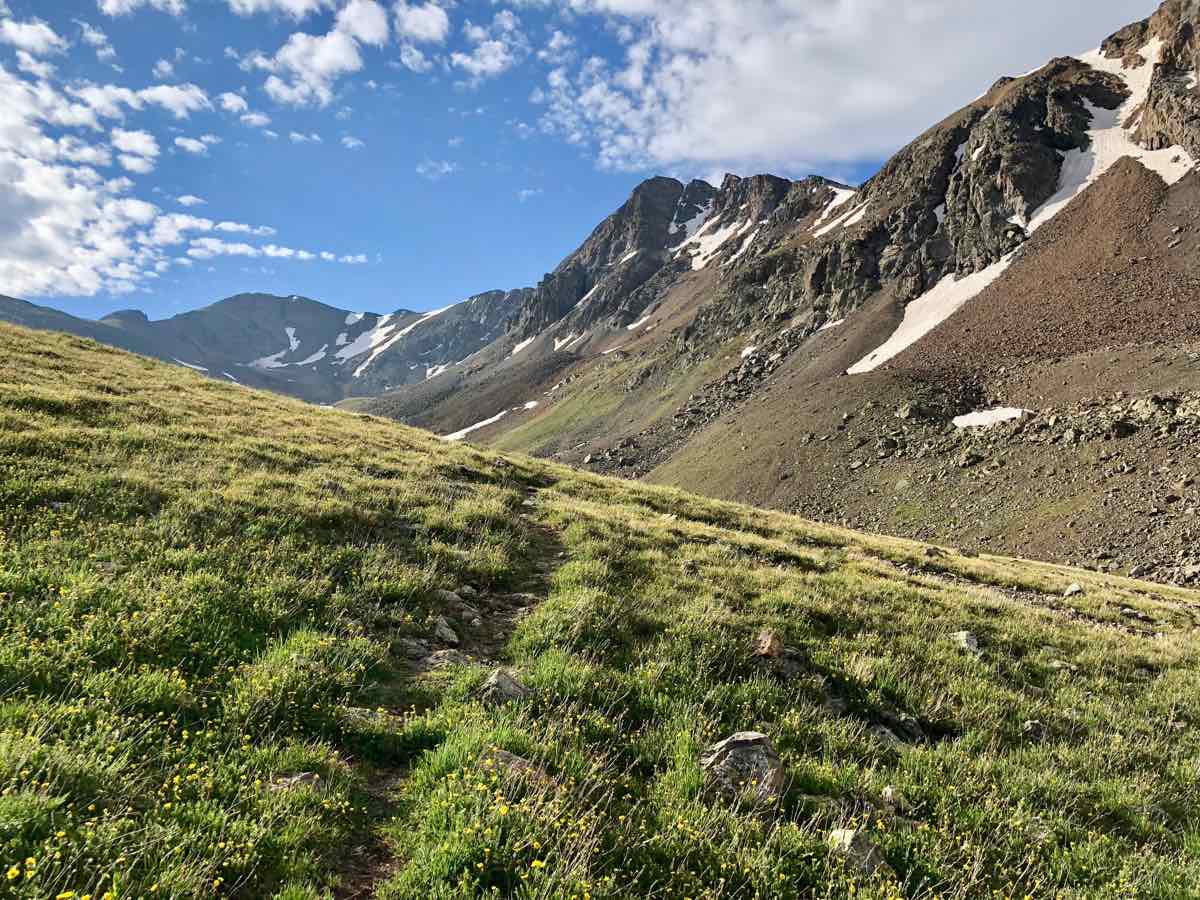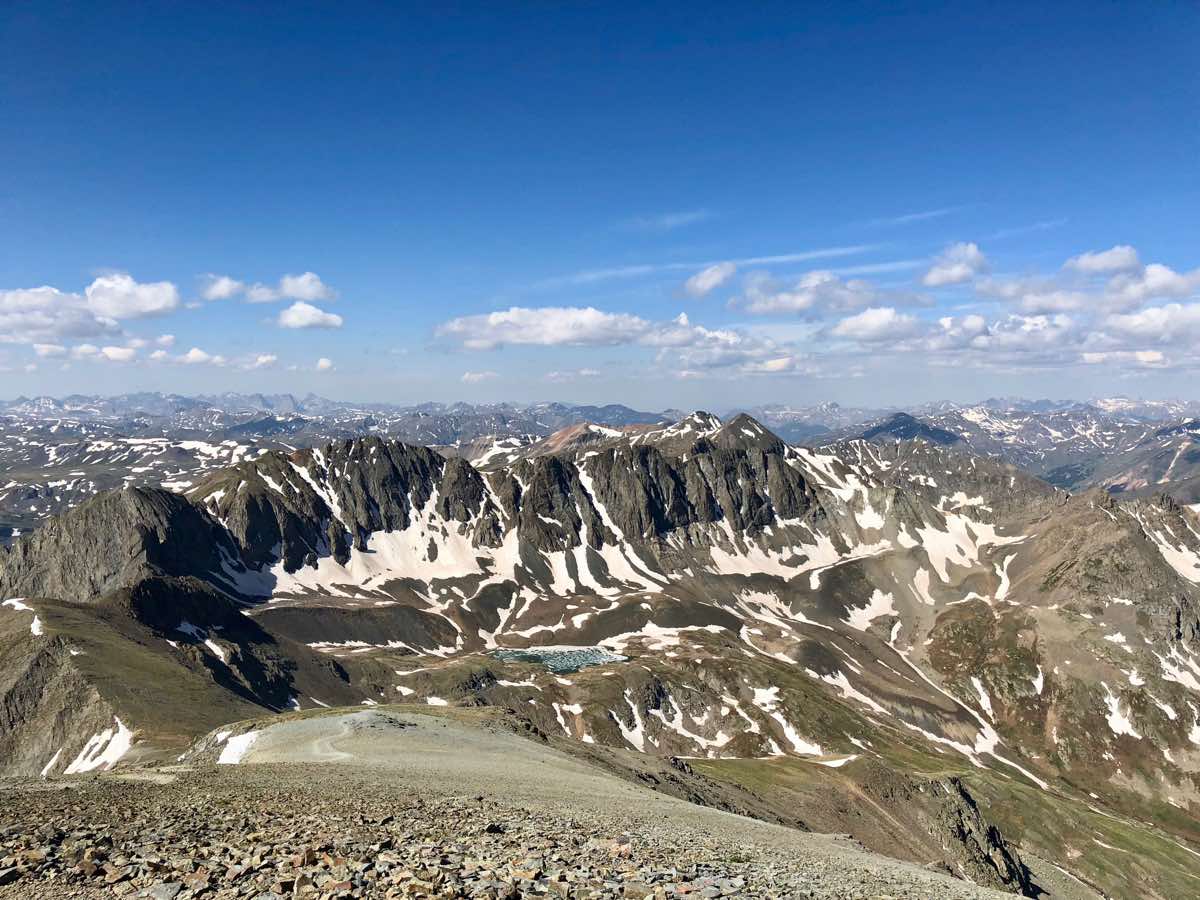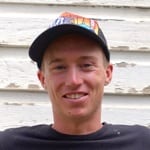[Author’s Note: This is an excerpt from a longer story still in progress.]
The San Juan Mountains of southwestern Colorado are known for many things. They are known for having 14 of the state’s fifty-four 14,000-foot peaks. They are known for having great skiing in places like Telluride and Wolf Creek. They are known for having a particularly well-preserved Victorian-era mining history and, therefore, for being the setting of many classic western films, including “True Grit” and “Butch Cassidy and the Sundance Kid.: They are known for hiking and jeeping and kayaking and just about any outdoor sport you’d care to partake in. They’re known for rock climbing too, because climbers naturally gravitate to big mountains like these. But among rock climbers, they are most definitely NOT known for having good rock.
Today, I am moving along a ridgeline high above two bowl-shaped valleys. Not too long ago, geologically speaking, glaciers filled these valleys nearly to their brims. These rivers of ice flowed downward at an imperceptible pace until they connected with other glaciers from other valleys, and eventually they all flowed out of the mountains together as just a few gigantic glaciers. This is all apparent now only by the way these mountains are built. There are no longer any true glaciers in Colorado. But my experience in the mountains is shaped by these unseen forces.
In this particular experience, the glaciers in the valleys on both sides of me scoured the mountainsides so thoroughly that I have only a narrow line upon which to walk. Below me to the right and left, fields of scree and boulders sweep away at something rather steeper than the angle of repose. I don’t want to fall. But the ridgeline is becoming ever narrower and now I’m actually balancing on small ledges with my feet while traversing across the side of a crumbling pinnacle of shattered granite. I test each rock with my hands before trusting it with my weight, and even then I trust them with the least amount of weight possible. You might say that all mountains are in a constant state of erosion, but the San Juans seem to have less glue holding them together than other ranges.
As I move along, slowly, carefully, I’m thinking about how best to get from here to a safer place. I’m also thinking about my dad. He brought me into these mountains for the first time, when I was a teenager, and he facilitated my transition from a normal, unexceptional kid to someone who has now dedicated 10 years of his life to being in such places. I am a trail runner and mountain climber by trade–literally–and the combination of those two things is where I’m most invigorated. This traverse is a good example of the delicate balance between the two disciplines, because I’m wearing running shoes but I could also die by falling. But I’m not here to test my abilities as an athlete. I’m here to remember.
Ten years have passed since the first time I came up here, 10 years in which I managed to turn an intense longing for exploration and adventure into a career. When I was here in 2008 on a camping trip with my dad, I had a profound realization. One day we were hiking together and I looked at the ridge above us and said it might be cool to be up there. “Well, why don’t you go up there?” my dad asked. So I did. And when I got up there I saw a peak at the head of the valley and decided to try climbing it too. I did that as well. By the end of the day, I had traversed several miles of rocky ridgeline all by myself, following just my whims, and I was filled with elation. At the camper my dad pulled out his maps and I realized that in these mountains, I could go anywhere. There were ridges extending in every direction from every point, all defined by high peaks and connecting with other ridges that extended off into the blue beyond. For the first time that night, I understood that my only limitations were imagination and stamina.
Over the next week, I became increasingly ambitious. Each morning before sunrise, my dad and I would start out hiking together with our dog Rosie between us. But after a mile or two we would invariably reach our agreed-upon parting, and I would head up some ridgeline while my dad continued hiking up the trail in the valley. Rosie, who as a Labrador was a particularly social breed, would go berserk as the party split up. My dad had to keep her on a leash so that she wouldn’t hurt herself trying to keep us together. I was proud to be going off on my own adventures. I felt older and trusted, and I knew my dad was proud of me. I never really questioned why he didn’t join me on these outings. He simply couldn’t keep up. At the time I just assumed it was because I was young and fit, while he was older and wasn’t able to get out as much. I know now there was more to it.
Up on this ridge 10 years later, the rock is becoming steeper and I need to descend in order to bypass this section of heaped towers. The vertical relief on this ridgeline is improbable because nothing seems to be connected to anything else. These pinnacles are just a pile of rocks. If you could harness potential energy, I expect the San Juans would power the nation. My only option is a steep gully below me, and I want to move through it quickly in case of rockfall. But as I get lower and the pitch lessens slightly, the ground beneath me feels all aquiver. Every rock I touch seems to propagate energy to the rocks around it, and I’m in a state of high alert and constant movement, almost swimming in this field of slow-moving rocks. I stick to the walls of the gully for a modicum of security, thinking the steeper the wall, the better the rock. But two different head-sized chunks break off at my touch and crash into the gully below me, leaving a burnt smell in the small space. I need to keep moving here, but that doesn’t seem to be the problem. I need to stay in control as the world moves underneath me, and that’s harder to do.
The memory of camping with my dad 10 years ago ebbs and flows. Some parts of it are as clear as the turquoise water of an alpine lake in summer, the kind that’s cold as fire and you can see every fish and rock under the surface. Other parts have faded, causing me to fill in the gaps with questions, or worse, with invented memories. Sometimes I’m nervous about even thinking of important memories like this, for fear of distorting them simply by considering them. I am a different person now, I have different ideas and priorities. I don’t want to wash my past with a layer of bias. But I’m afraid it’s impossible not to.
Similarly, 10 years is a satisfyingly circular amount of time. The reason I’m on this sketchy ridge in the first place is to physically retrace the biggest route I did that summer of 2008, the one which followed the Hardrock 100 course for some miles and then peeled off onto this chossy traverse. The weekend following our camping trip, I volunteered at Hardrock and was given a visceral experience of mountain running. Coming directly on the heels of my ridgeline hiking revelation, Hardrock demonstrated to me in one long, chilly, busy night at the 50-mile mark that mountain running offered all the adventure I sought in mountain climbing, but with almost none of the prohibitive time and expense of technical climbing. I lived in these mountains, and I had running shoes already. As the last runners filtered through my aid station in the pre-dawn light of that cold July morning, I warmed myself at the fire and burned inside with desire.
In time, I made this kind of thing my life. And the reason I’m following 17-year-old me’s footsteps across this ridge is to try to find some element of continuity between then and now, some vibrant pulse that has hummed through my dreams for the duration of my life in the mountains. There are many options. There is Potential, as in the possibility of the next ridge, the next mountain. There is Adventure, as in the transformative experiences of overcoming unexpected obstacles. There is Companionship, as evidenced even just today on the Handies Peak trail when I passed probably two dozen people and knew half of them by name. But as I wade through the swirling rocks below these leering pinnacles, I’m struck by the feeling that these are all a bit too literary. They don’t feel real to me in this moment. What looks good on paper doesn’t necessarily describe life experience, which at this moment seems to be a jumbled collection of memories with no adhesive to hold them together.
It’s especially hard to keep my memories together when I can’t even remember all of them. They swirl like thunderclouds building in the sky over the mountains on a July day, at first sharply defined and then washed against others until they form a towering mass of confused action. There are some photos of that summer, and I think I wrote about it in a journal once, somewhere. But the real problem is that I can’t relax and let these memories be what they are. They are too important to me and I grip too tightly. That summer helped me become who I am. More importantly, that was the last summer I got to see my dad as he wanted to be.
There’s one memory that I can maintain better than the rest, and this seems like a good place to start. It was on the very day that I’m now repeating. My dad and I had left our camper as the first brushstroke of light washed the eastern horizon, and we both followed the Hardrock course up and over a pass. By the time he reached the pass, though, I was far ahead in the next basin, climbing the highest point on the 100-mile course. I made better time than even I expected, ambitious as ever, and in less than three hours, hiking with a pack, I had summitted Handies Peak and returned to the first pass. From there I would strike off to the south, to navigate an intimidating pile of rock towers and then to climb two more peaks, both of them close to 14,000 feet high. I felt good.
But before heading up, I paused at the pass and looked up the ridge to the north. It was a broad grassy slope that ended abruptly on the right side, a cliff out of sight. The gentle slope on the left angled upward to a distant point that was less of a point and more just a narrowing of the horizon. There were only a few colors, just green and grey and blue and a little white where the snow hadn’t yet melted on this southern slope. It didn’t look very large or high, and at first I didn’t think they were there. The grasses waved in the wind, looking like they were straining to uproot themselves and fly away, and the wildflowers were swatches of color on a green canvas. But then I noticed movement, and I realized they were right in front of me. I had expected them to be higher. The movement was Rosie, our dog, a black shape darting back and forth among the grasses. To her left I picked out my dad. He was a thin line of human in a big slope of green, wearing muted colors and hauling a large pack. He toiled uphill, the pack hunching his back, the perspective bending his head, determinedly stepping forward. Rosie ran up and down and around him, investigating everything while he maintained his course.
It was green grass and two dots moving uphill. Around them was a fisheye lens of blue, the sky bending over and around them like a benevolent older sibling, cradling their upward march. I stood on the pass below and watched them move and felt a pang of melancholy that made me consider joining them for one brief instant. But that wasn’t the plan, and I knew it wasn’t my path. There were two peaks behind me to climb still and I was eager to see his face when I was done. So I looked at my dad and his dog for a short while longer and then turned my back on them and started up the next mountain.
A few minutes later–and a few hundred feet higher–I looked again, but I could no longer pick them out. They had blended into the details like an old memory. There was a ridge, and there was the sky, and nothing moved but the unanchored wind above the peaks.
Call for Comments (from Meghan)
- What physical place on earth are you more tied to than others? Can you articulate how that geography has affected other parts of your life?
- From whom did you learn your outdoor skills? Did you or do you have a mentor who has not only taught you how to move and be in the outdoors, but who has contributed to your mental approach as well?



